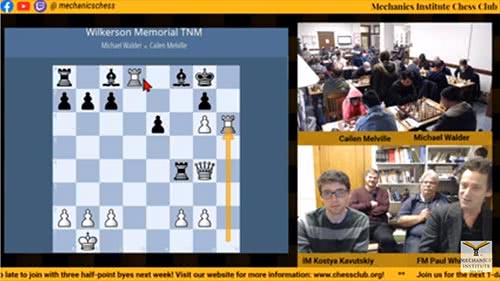
The song “I left my heart in San Francisco” fits the Mechanics’ Institute Chess Club. Chess players who have visited the Mechanics’ Institute Chess Club once yearn to return to it; those lucky enough to live in San Francisco visit it often. In this article, I reminisce about my first visit to San Francisco and then share an exciting game from the third round of the Max Wilkerson Memorial Tuesday Night Marathon.
On my first visit to San Francisco, in the summer of 1982, I hadn’t worked out where I would stay. Luckily, chess-playing brothers Paul and Jay Whitehead and their mom Loretta offered to host me in their Haight-Ashbury neighborhood home. Paul is a FIDE Master and Jay was an International Master.
In “I left my heart in San Francisco,” Tony Bennett sings, “To be where little cable cars climb halfway to the stars.” As evening fell after a day of sight-seeing, I asked Paul if we could ride on a cable car. Soon, I was absolutely freezing. Another famous San Francisco line is attributed to Mark Twain: “The coldest winter I ever saw was the summer I spent in San Francisco.” I will never forget that Paul chivalrously took off his jacket and handed it to me.
On the Tuesday Night Marathon broadcast, Paul wears a jacket, though presumably not the same one that he loaned me in 1982. Alongside special guests and the Mechanics’ Institute Chess Club staff, Paul analyzes chess club members’ games. There are various “Tuesday Night Marathons” throughout the year; the January-to-February one is named after former Mechanics’ Institute Chess Club Director Max Wilkerson. I recommend that you watch, at 1:42 [one hour, 42 minutes], analysis of the game Michael Walder versus Cailen Melville. Those two players joined Paul and his co-host for the evening, IM Kostya Kavutskiy, for a post-mortem (a practice described in a previous SparkChess article).
A former master and current expert, Walder played a thematic sacrifice, 13. Bxh7+, which was unsound, according to Paul and Kostya. Later annotations by IM Elliott Winslow, who incorporated computer analysis, also found holes in White’s aggressive ideas. Nonetheless, White won.
At 1:57 into the video, Paul concludes the post-mortem with this compliment to Walder, “This game has a place. And the place for this game is for the diagram for the last two moves…. But it also illustrates a very important point. That the aggressor gets rewarded often…. To compare yourself with Tal in this situation is perfectly justified…. What a brilliant and poetic finish to the game that anybody would be proud of.” At 1:59:50, Paul turned his attention to the person who lost, Cailen Melville, who is rated 1884. “It takes a great game to beat a great player. Cailen, keep it up, man!”
Look at the diagram below, a screenshot from that Tuesday Night Marathon broadcast, Walder, as White, has just played 23. Rxh6, capturing a queen, which caused Melville to resign. Why can’t Black play 23…Rxg4, also capturing a queen, and be material ahead? See if you can find the continuation for White to win brilliantly. The answer is at the end of the article.

Although Paul didn’t literally give his jacket to either Walder or Melville, he figuratively did. Both players undoubtedly felt warmed by Paul’s kind words.
The answer: If 23…Rxg4 then 24. Rh8+ Kxh8 25. Rxf8#.

Everyone at the MI was overjoyed to see this article. I have done some broadcasts with Paul, and he is always a blast to work with!